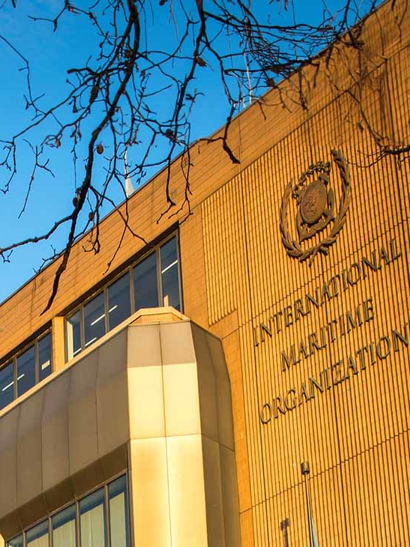It was 2021’s COP26 in Glasgow that built on the idea that global shipping is not only as a sector that needs urgently to slash its own greenhouse gas emissions but which also, as a key mode of bulk transport, is a source of climate action. The momentum built in Glasgow gathered pace at COP27 where the role of international shipping was again seen as fundamental to a safe, sustainable and fair energy transition.
Katharine Palmer, shipping lead for the UN High Level Climate Champions, moderated the webinar in which panelists discussed the takeaways from COP27 and how these could shape developments in the months ahead. The tone was broadly upbeat but participants agreed that an ambitious and clear regulatory framework is essential if the necessary carbon-cutting initiatives are to be made in time.

Revisions to the IMO GHG strategy due in July 2023
Michael Wiseman, Head of International Emissions Policy for the UK Department for Transport, questioned what progress in Egypt could mean for the IMO’s 80th Marine Environment Protection Committee (MEPC 80) in July 2023, when the UN agency’s Initial Greenhouse Gas Strategy is due for revision, with many hopeful that MEPC 79 in December 2022 will create the right conditions for change. He said shipping does not have time on its side and it may find more pressure on its budgets than other hard-to-abate sectors such as steel and cement.
Ambassador Albon Ishoda, Marshall Islands' Ambassador, declared the overwhelming plus point for him was clear evidence of the will to keep the 1.5°C target alive. “It is clear we can do more and go faster,” he said, “but we need IMO to provide a single, universal regulatory regime that provides certainty for equity and ambition, and ensures that we can unlock the technology and the investment capital that we know is available.
“The ‘polluter pays’ principle must be applied,” he continued, “and that means a significant price on shipping emissions. It means a clear commitment to aggressive 2040 and 2050 goals, and it means ensuring that the transition is equitable and leaves no-one behind. Going hard and early will always be the least cost option and the right thing to do.”
Fortescue’s Charlotte Kirk gave the viewpoint of a private sector developer of green hydrogen and ammonia as carbon-free energy sources. She says shipping is now being seen as a source of climate solutions. Given that 80% of the world’s goods move by sea, an early source of demand and bankable offtake projects can underpin the development of alternative zero-carbon fuels, she said.
“That will enable the scale-up of the green hydrogen industry as a whole,” she explained, “which can have a much broader impact on the hard-to-electrify sectors… it is overwhelmingly clear that the scaling and acceleration that are required will demand radical collaboration across all stakeholders.”
Cross-sector collaboration
LR’s Charles Haskell listed a range of projects, initiated in Glasgow last year, that are developing and expanding. These include the World Economic Forum’s First Movers’ Coalition which now has 12 shipping companies among its membership of close to 70 organisations.
He also noted the doubling in size of coZEV (Cargo Owners for Zero Emission Vessels) with new members including DuPont, Electrolux and Phillips. Meanwhile, the Clydebank Declaration has spawned the development of some 20 green corridor consortia.
“The overall message for me,” said Haskell, “is that industry is ready to take risks. There are some world leaders and companies out there prepared to take risks, but the overwhelming message is that these risks will be massively reduced with strong policy measures. This is what’s being asked because with those strong policy measures, more will join and the risks will be lowered significantly moving forwards.”
UCL’s Tristran Smith noted that what he described as the “hydrogen opportunity” has now been spotted outside shipping and the big hydrogen producers have spotted that shipping could be a key source of demand, supporting business cases and investment. He noted Africa’s enormous hydrogen potential and scope to ensure that future energy development follows a more equitable transition.
Regulation required
He issuing a stark warning about the need for regulation. Without a strong enough outcome at MEPC 80, the transition will be led by individual companies and countries taking action, he said, because they have no other choice but to do so. These entities may state their aims for net zero by 2050 but details are likely to be lacking. And he highlighted the importance of a paper published by The High-Level Expert Group on the Net-Zero Emissions Commitments of Non-State Entities.
The Group’s advice leaves no room for anyone to hide, Smith declared, because they have a clear set of criteria about what a credible commitment to net-zero really means. They turn generic statements and claims into specifics. “These specifics are about 1.5 (degree target). They include Scope 1, 2, 3 emissions, all greenhouse gases, upstream emissions, and actual operational emissions. So we can see this kind of alternative scenario has a lot of credibility and that’s what’s so challenging… we will end up with something less equitable unless the IMO get its ambitions correct.”
“Reddest of all red lines”
Palmer asked panelists to look forward to the thirteenth meeting of the IMO’s Intersessional Working Group on Reduction of GHG Emissions from Ships. How could countries like the Marshall Islands convey the importance of 1.5 to the IMO, she asked Ambassador Ishoda.
“For many island nations across the world, particularly the Marshall Islands because we’re low-lying, climate change is an existential threat. For those of you who have never been to my islands, it can be hard to comprehend the extent of our vulnerability… Together with our Pacific brothers and sisters, we were instrumental in negotiating the Paris Agreement and enshrining the goal of 1.5° limit. And it is the reddest of all red lines for us.”
He revealed that the Marshall Islands, Solomon Islands and New Zealand are co-sponsoring a resolution at MEPC 79 to require complete emissions reductions no later than 2050, with a reduction of more than 80% by 2040 on a well-to-wake basis.
“That, quite simply, is the minimum scientific requirement or ambition, and we are confident that all ambitious member states and industry representatives will support this. But, of course, once we set that target, we need also to have the measures in place to achieve it.”

New targets needed
“It was the incredibly weak 2030 carbon intensity target, the 40% improvement on 2008, that gave us the weak outcome on CII and EEXI,” Smith declared. “So what we really need to do is use this opportunity to get those numbers right.”
Smith said that the soft approach would be to hold emissions roughly constant until 2030 and then face a very rapid, more expensive and extremely disruptive transition thereafter. A better strategy, he suggested, would be to implement larger cuts today to meet a more ambitious goal by 2030.
“That’s the pathway that we’ve identified that has a lower cost and the lowest level of disruption. But it does involve us making ambitious numbers for a material greenhouse gas reduction by 2030. Depending on how much we do by then … somewhere between 80% and 100% by 2040.
Reinforcing the requirement for action today, Smith proclaimed: “It’s not really about zero by 2050, it’s really about what happens in the 2030s.”













